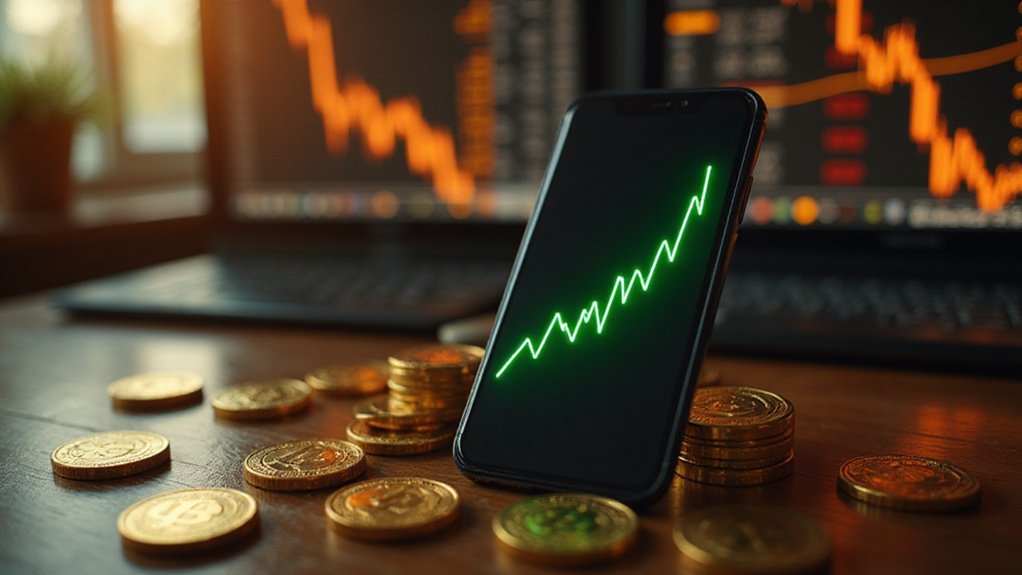Digital assets represent a fundamental reimagining of ownership, transforming intangible bits into verifiable value through blockchain technology. Cryptocurrencies like Bitcoin operate independently of government oversight, while NFTs create unique digital collectibles that somehow convince people to pay thousands for pixelated art. Security tokens digitize traditional assets, enabling fractional ownership of everything from penthouses to Picassos. Central banks now issue their own digital currencies, desperately attempting to maintain relevance in this brave new monetary landscape that continues evolving.

How does one categorize an asset that exists purely in digital form yet commands real-world value that can exceed the GDP of small nations?
The answer lies in understanding digital assets—a sweeping category encompassing anything digital with verifiable value, ownership, and discoverability.
Digital assets fundamentally redefine ownership itself—transforming intangible bits into verifiable, tradeable value that challenges centuries of economic convention.
From mundane photographs and documents to blockchain-minted cryptocurrencies, these assets represent a fundamental shift in how society conceptualizes ownership and exchange.
Cryptocurrencies, perhaps the most notorious subset, operate as digital currencies secured through cryptography, functioning independently of governmental oversight (a feature that simultaneously thrills libertarians and terrifies central bankers).
Bitcoin, Ethereum, and their numerous progeny record transactions on public blockchains, creating transparent ledgers that would make traditional accountants weep with either joy or confusion.
These tokens can be mined through computationally intensive processes, purchased on exchanges, or earned as network rewards.
The digital asset ecosystem extends far beyond simple currencies, encompassing fungible tokens that exchange seamlessly one-to-one and non-fungible tokens (NFTs) representing unique digital items—because apparently, the art world needed additional complexity.
Security tokens digitize ownership stakes in traditional assets like real estate or corporate shares, subjecting themselves to securities regulations while promising increased liquidity and fractional ownership opportunities.
Tokenization emerges as perhaps the most pragmatic application, converting previously illiquid assets into blockchain-based representations.
This process democratizes investment access, enabling fractional ownership of everything from Manhattan penthouses to Renaissance paintings (assuming one trusts smart contracts over centuries-old legal frameworks).
Central Bank Digital Currencies (CBDCs) represent governments’ attempts to harness blockchain innovation while maintaining monetary control.
China’s digital yuan and the Bahamas’ Sand Dollar illustrate how sovereign authorities seek to modernize payment systems without relinquishing oversight—a delicate balance between innovation and control.
The broader implications prove transformative across industries, with blockchain technology ensuring transparency and traceability while regulatory frameworks scramble to establish coherent oversight. These digital assets function through wallets securely storing the cryptographic keys that enable users to view and manage their holdings. Custodial wallets managed by exchanges like Coinbase handle key storage for users, while non-custodial alternatives provide complete user control over private keys. Digital assets generate revenue through demand-driven sales on NFT marketplaces, trading on exchanges, or through price appreciation.
These developments signal not merely technological advancement but a fundamental restructuring of financial architecture, creating new investment paradigms and business models while challenging traditional notions of asset ownership and exchange in an increasingly digital economy.
Frequently Asked Questions
How Do I Pay Taxes on Cryptocurrency Gains and Losses?
Cryptocurrency holders must report all taxable events—sales, trades, mining rewards—calculating gains and losses for each transaction.
Short-term holdings (under one year) face ordinary income rates up to 37%, while long-term positions enjoy preferential rates of 0%, 15%, or 20% based on income thresholds.
Starting 2025, brokers will issue tax forms, though investors remain responsible for accurate reporting using specialized software or professional guidance to navigate this labyrinthine compliance landscape.
What Happens to My Crypto if I Lose My Private Keys?
Losing private keys renders cryptocurrency permanently inaccessible—no central authority exists to restore access, unlike traditional banking systems.
The assets remain on the blockchain but become effectively worthless to the owner, who cannot authorize transactions without the cryptographic signature.
Unlike the tax implications discussed previously, this represents total capital loss.
Hardware failures, forgotten passwords, or device theft commonly cause such losses.
Multi-signature wallets and secure backup strategies provide the only meaningful protection against this digital nightmare.
Which Cryptocurrency Exchange Is the Safest for Beginners?
For beginners exploring cryptocurrency’s Byzantine landscape, Coinbase emerges as the prudent choice—its regulatory compliance and user-friendly interface offset higher fees that might otherwise induce sticker shock.
Gemini offers similar security credentials with institutional-grade cold storage, while Kraken provides robust liquidity for those ready to graduate beyond basic buying.
Each platform’s insurance coverage becomes particularly relevant when considering our previous discussion about private key catastrophes, offering some protection against exchange-side mishaps.
Can I Use Cryptocurrency to Buy Everyday Items Like Groceries?
Cryptocurrency purchases for mundane groceries remain frustratingly limited despite growing merchant adoption.
While payment processors like BitPay enable transactions at thousands of outlets, most supermarkets and pharmacies still reject digital assets.
Even with 28% of Americans owning crypto, practical hurdles—transaction fees, processing delays, tax implications—make buying milk with Bitcoin rather impractical.
The gap between crypto enthusiasm and everyday utility persists, leaving holders dreaming of decentralized dinner shopping.
How Much Should I Invest in Crypto as a Percentage of Portfolio?
Financial advisors typically recommend allocating 1-5% of one’s portfolio to cryptocurrency, though risk-tolerant investors might venture up to 20%.
Beyond modest allocations, crypto’s volatility becomes problematic—a 10% allocation increases portfolio volatility by 41%.
Modern portfolio optimization suggests capping exposure at 2-3% for most investors, given crypto’s evolution from diversifier to correlated risk asset following institutional adoption.









